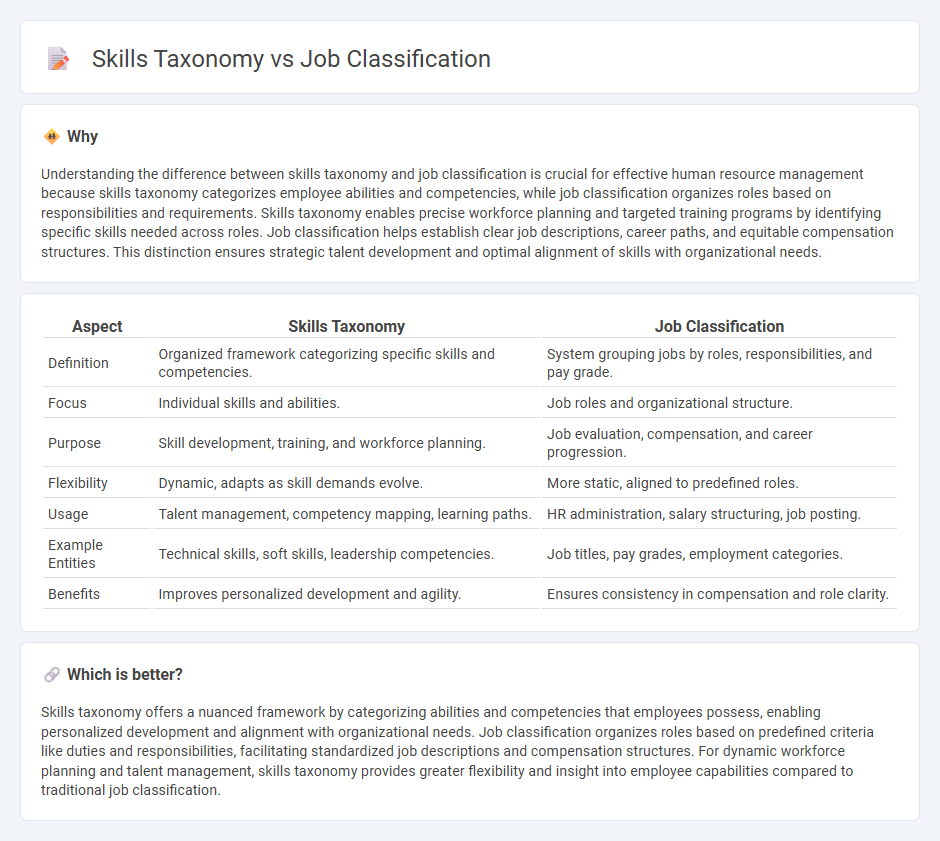
Skills taxonomy organizes employee abilities and competencies into structured categories, enabling precise workforce planning and tailored professional development. Job classification groups positions based on duties, responsibilities, and qualifications, facilitating equitable compensation and compliance with labor regulations. Explore how integrating skills taxonomy with job classification enhances talent management and organizational efficiency.
Why it is important
Understanding the difference between skills taxonomy and job classification is crucial for effective human resource management because skills taxonomy categorizes employee abilities and competencies, while job classification organizes roles based on responsibilities and requirements. Skills taxonomy enables precise workforce planning and targeted training programs by identifying specific skills needed across roles. Job classification helps establish clear job descriptions, career paths, and equitable compensation structures. This distinction ensures strategic talent development and optimal alignment of skills with organizational needs.
Comparison Table
| Aspect | Skills Taxonomy | Job Classification |
|---|---|---|
| Definition | Organized framework categorizing specific skills and competencies. | System grouping jobs by roles, responsibilities, and pay grade. |
| Focus | Individual skills and abilities. | Job roles and organizational structure. |
| Purpose | Skill development, training, and workforce planning. | Job evaluation, compensation, and career progression. |
| Flexibility | Dynamic, adapts as skill demands evolve. | More static, aligned to predefined roles. |
| Usage | Talent management, competency mapping, learning paths. | HR administration, salary structuring, job posting. |
| Example Entities | Technical skills, soft skills, leadership competencies. | Job titles, pay grades, employment categories. |
| Benefits | Improves personalized development and agility. | Ensures consistency in compensation and role clarity. |
Which is better?
Skills taxonomy offers a nuanced framework by categorizing abilities and competencies that employees possess, enabling personalized development and alignment with organizational needs. Job classification organizes roles based on predefined criteria like duties and responsibilities, facilitating standardized job descriptions and compensation structures. For dynamic workforce planning and talent management, skills taxonomy provides greater flexibility and insight into employee capabilities compared to traditional job classification.
Connection
Skills taxonomy organizes and categorizes employee abilities, enabling clear identification of competencies within an organization. Job classification uses this structured skills framework to group roles based on required skills and qualifications, ensuring consistent job descriptions and performance standards. Integrating skills taxonomy with job classification enhances talent management, workforce planning, and recruitment efficiency in Human Resources.
Key Terms
Job Roles
Job classification organizes positions based on standardized categories emphasizing job titles and responsibilities, facilitating HR management and reporting. Skills taxonomy categorizes the specific abilities and competencies required to perform various tasks within those roles, enhancing talent development and workforce planning. Explore how integrating job roles with skills taxonomy can optimize recruitment and employee growth.
Competencies
Job classification organizes roles based on criteria like responsibilities and level, while skills taxonomy categorizes abilities and knowledge areas essential for performance. Competencies bridge these frameworks by defining measurable behaviors and skills required for job success, enabling targeted employee development and accurate talent management. Explore how aligning job classification with skills taxonomy enhances competency mapping and workforce optimization.
Skill Sets
Job classification categorizes roles based on duties, responsibilities, and organizational hierarchy, providing structured titles and levels. Skills taxonomy organizes and defines specific skill sets, enabling targeted workforce development, talent matching, and competency management. Explore how integrating job classifications with comprehensive skills taxonomies enhances workforce agility and strategic talent planning.
Source and External Links
Understanding Job Classification - Job classification is a system companies use to categorize job roles by assigning each position a grade based on tasks, responsibilities, pay level, and duties to ensure fair compensation and clarity in job responsibilities within the organization.
Job Classification: A Practitioner's Guide - Job classification defines the relative rank of jobs in an organization by grouping roles into families and hierarchical steps, helping create equitable pay structures and clarify organizational job levels.
Job Classification: HR Terms Explained - This system groups jobs based on similarity in tasks and required skills to match employees with positions, identify training needs, and establish fair compensation and career paths.
 dowidth.com
dowidth.com